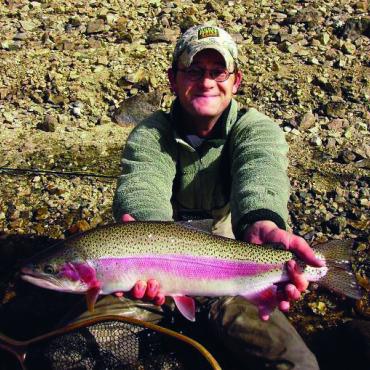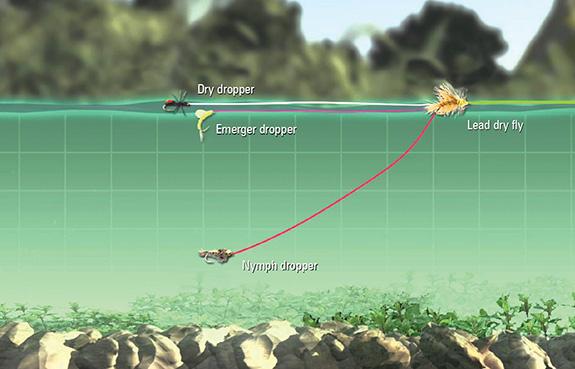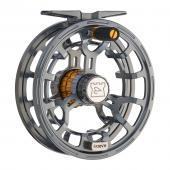Dropper Rigs
It’s a fact that the tug of a fish on the end of your line releases chemicals in the pleasure center of the brain. This in turn causes an angler to seek out that experience more often, like an addict. If you don’t use the right setup at the right time, you won’t be able to get your fix, which is why I’ve provided the following three rigs to help you scratch that unceasing itch.
Dry Dropper / Tandem Dry-Fly Rig
This is a classic way to fish two dry flies simultaneously, and works best when it’s hard to discern what surfacing trout are eating. A favorite among area guides utilizes a larger, flashier attractor pattern as the lead fly and a smaller, more specific fly as the trailer, like a size-12 orange stimulator trailed by a size-16 tan x-caddis. This rig also works well with terrestrial patterns. Tie the bigger ant or beetle patterns on as the lead fly and then trail the more specific patterns below. You can also use emergers and soft hackles as the droppers. The lead fly acts as a strike indicator, helping you detect those slight semi-subsurface takes. Fish these tandem rigs close to the bank, in swift, shallow riffles, and anywhere insects are likely to get caught up in the current and pushed toward feeding areas. I prefer to use 7.5-foot mono leaders for these rigs in 3X; I’ll drop down one or two tippet sizes to tie on the dropper, depending on the water clarity and spookiness of the fish. I tie the dropper tippet to the bend of the hook, but some anglers prefer to tie their droppers to the eye of the lead fly.
Big Nymph, Little Nymph
This double-rig technique is popular and highly effective. A favorite of bobber-lobbers and driftboat anglers, it works best on hot summer days when fish are hugging the bottom. The setup on this leader begins with a strike indicator. I use 9-foot, 3-4X fluorocarbon leaders for this rig. Pin or attach the strike indicator according to the depth of water you’ll most likely be fishing. Next, add about a foot or so of tippet. Above this knot, crimp on a split-shot—I almost always use a B or BB size and then adjust the weight throughout my fishing day depending on water depth. For the big nymph, a Pat’s rubber legs is a great starting point—feel free to play around with the color combinations. As the season progresses I’ll also use larger-sized (#12-14) flashback hare’s ears, prince nymphs, pheasant tails, or copper johns as my lead fly. For droppers, use soft hackles, midge larva, or prospecting nymphs. Over the last few years I’ve had great luck with some of the new micro-jig patterns. Keep these bugs on the small side, #16 and down. The best way to fish these rigs is from a boat, but if you’re wading, cast as far upstream as possible and really work on a long, drag-free drift. These rigs really excel in deeper waters or in areas where the current forms a shelf and the water quickly goes from shallow to deep. The trick to fishing these rigs is to keep adjusting the depth until you find the feeding zone of the fish you’re targeting. Before you change fly patterns, try adding a little more weight on the next drift.
Dying Guppy
This rig is basically the same one as above, but instead of nymphs, use tandem streamers. This particular setup works wonders early in the season, or anytime the water muddies up a bit, as the more predatory fish are emboldened by the cover. Rig the indicator and split-shot as mentioned above, but keep the tippet in the 3X range, as some of these flies can get heavy when wet. The lead fly on this rig should be a #10 to #8. I like baitfish patterns such as zonkers, Bow River buggers, and marabou muddlers, but a run-of-the-mill woolly bugger works fine too. The dropper on this rig is another baitfish pattern; my favorite is the epoxy minnow. Available in several different colors, these flies imitate trout or whitefish fry and really work well on a tandem rig. The technique to fishing this rig properly is to let the current do most of the work. A hard mend now and then that lifts the indicator slightly out of the water will provide all the needed action. Try to imitate two wounded, dying, or disoriented baitfish, at the mercy of the current. The best time to fish this rig is when there’s one to two feet of visibility in the water. Fish just at or slightly on the edge of the clearer water, and get ready to get your trout fix on.
Kurt Dehmer owns Durty Kurty’s guide service in Bozeman.












